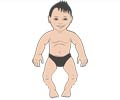
‘High Body Mass Index (BMI) at age two months is a better predictor of childhood obesity at two years of age than Weight-for-Length (WFL).’
Tweet it Now
Roy added that the American Academy of Pediatrics currently recommends using weight-for-length (WFL) as a standard measurement during infancy, and that WFL is also predominantly used worldwide. BMI is widely used in children over age two years to identify those at risk for health complications of excess weight or future obesity. BMI charts are available from birth to age two, but are generally not used in clinical care. Unlike BMI charts, the more widely used WFL charts, do not have an age component; therefore, children with similar WFL may differ greatly in age. Because gains in weight and length occur at different rates during infancy, it is important to account for both age and length when evaluating excess weight gain.
In the current research, the study team analyzed medical records of nearly 74,000 full-term infants seen during their first two years at well-child visits in the CHOP pediatric network from 2006 to 2011.
The authors found it remarkable that 31 percent of two-month-old babies with BMI at or above the 85th percentile were obese at age two, compared to 23 percent of two-month-olds at the 85th percentile by WFL. At the 97.7th percentile for BMI at age two months, 47 percent of babies were obese at age two years compared to 29 percent by WFL.
"To our knowledge, this was the first study to compare BMI to WFL in predicting future obesity risk in a large, diverse cohort of full-term infants," said senior author Babette S. Zemel, the director of CHOP's Nutrition and Growth Laboratory. "We found that while BMI and WFL agreed after age six months, high BMI at age two months was a better predictor of obesity at two years of age than WFL. We recommend that clinicians consider measuring BMI in early infancy."
Advertisement















